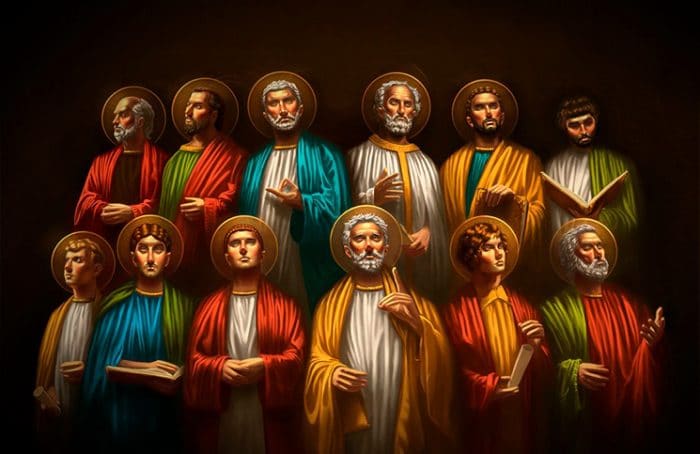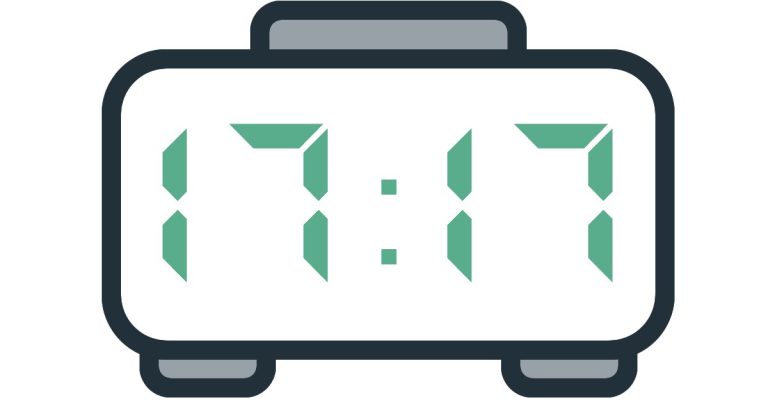Who Were The 12 Apostles? Chosen By Jesus
The 12 Apostles are the Twelve people that Jesus came to choose as his disciples so that during their stay in this world they could learn everything about the things of the kingdom of heaven. If you are more interested in this topic, I invite you to learn much more about the life of each one of them and to know who was the one who sold it.
Who Were the 12 Apostles?
When you hear the stories about the life of our Lord Jesus, you come to think that the apostles and the disciples became the same people, however, this is usually not exactly the case.
“Around Jesus there were concentric circles of people. From the inside out, Pedro, Santiago and Juan could be pointed out as the 3 closest friends to him. Then there would be the rest of the group of the twelve apostles . Later, another much larger group, that of the 72 disciples”.
This is what a man named Julián Lozano, the parochial vicar of Santa María Magdalena, in the town of Ciempozuelos in Madrid, details. Which also clarifies the following:
“The difference between these 2 groups is that the 12 apostles of Jesus are chosen by him to follow him more closely. The 72 become people who always choose to accompany Jesus in certain moments of his public life”.
This man also goes so far as to comment that the apostles to whom the most vocation is professed today become “the 3 closest: Saint Peter, Saint John the Evangelist and Saint James the Apostle.”
List of the Twelve Apostles
The disciples, or apostles, of Christ became the foundation stones of his church. In the book of Revelation 21:14 it is even said that the twelve foundations of the wall of the New Jerusalem will have the names of the 12 disciples or the 12 apostles inscribed on them. It is evident, in this way, that our Lord attaches great importance to these men. The biblical quote says the following:
“And the wall of the city had twelve foundations, and on them the twelve names of the twelve apostles of the Lamb.”
Revelation 21:14
Based on what is studied about these courageous first-century lives, and what discipleship came to mean at the time of Christ, one can expect to receive help in developing a 20th-century discipleship that is led by the Spirit. as Christ must have meant it to be.
This is the list with the names of each of the twelve apostles that Jesus chose to be his disciples and become responsible for expanding the Kingdom of God and his Justice on the face of the earth. The names of the 12 apostles are as follows:
- Pedro
- Santiago, the Elder
- Juan
- Andrew
- Bartholomew
- James the Younger
- Judas Iscariot
- Judas Thaddeus
- Matthew
- Philip
- Simon
- Thomas
This list can be corroborated with the following Biblical Quote that says:
“Then Jesus went up on a hill, and called those who seemed good to him. Once assembled, he chose from among them twelve, to accompany him and to send them to announce the message. To these he gave the name of apostles, and gave them authority to cast out demons.
These are the twelve whom he chose: Simon, whom he gave the name of Peter; James and his brother John, sons of Zebedee, whom he called Boanerges (that is, “Sons of Thunder”); Andrés, Felipe, Bartolomé, Mateo, Tomás and Santiago, son of Alfeo; Thaddeus, Simon the Canaanite, and Judas Iscariot, who later betrayed Jesus.”
Mark 3:13-19.
Now we are going to learn a little more about the life of each one of them and how it was that our Lord Jesus chose them for this important work in this world.
Pedro
The one who is currently known as the Apostle Peter, is one of the main disciples of Jesus, he was a man who was previously called Simon son of Jonah, before being one of the 12 apostles of Jesus, a great fisherman who came to live in the regions of Bethsaida and Capernaum. This man even left his house and all his things to follow Jesus when he began to preach. He came to do evangelistic and missionary work among all the Jews, going very far.
He became a member of the Inner Circle and wrote the 2 New Testament epistles that bear his name. The Gospel of Matthew goes so far as to tell that one day Jesus said to him:
“You are Peter and on this rock I will build my Church and the gates of Hades will not prevail against it. I will give you the keys to the kingdom of heaven, and whatever you bind on earth will be bound in heaven, and whatever you loose on earth will be loosed in heaven.”
For this reason, Pedro is usually represented with keys in his hand. The biblical verse that comes to mention the call of Peter is the following:
“Santiago (Jacobo) and Juan, two of Pedro’s friends, were brothers. Jesus told Peter, James, and John to follow him and be “fishers of men.” They left everything they had and accompanied Jesus. El Salvador also asked other men to follow him.”
Matthew 4:18–22; 9:9; Luke 5:10–11; John 1:35–51.
Within the Catholic Church, the apostle Peter is considered the first pope. After leaving Jerusalem, he lived in Antioch and later settled in Rome. The Christian tradition tells that he was in that place where he died. In each of the apostolic lists, the name of Peter comes to be mentioned in the first place.
However, Peter came to have other names. In the time of our Lord Jesus, the common language became Greek and the familiar language became Hebrew. In such a way that his name in Greek was Simon according to what the book of Mark 1:16 and John 1:40-41 says.
The name in the Hebrew language became Cephas according to what the book of 1st Corinthians 1 says: 12; 3:22; 9:5 and Galatians 2:9. The meaning of Simon in the Greek language was Rock. In the case of the Arabic language Cefas means Rock.
There he was crucified upside down by order of Emperor Nero. In his honor the Basilica of Saint Peter in the Vatican was erected. Peter was a Galilean man just as many of his other disciples became. Josephus came to describe the Galileans as follows:
“They were always fond of innovation and by nature open to change and delighted in sedition. They were always ready to follow the leader and start an insurrection. They were quick to temper and given to fighting and were very gentlemen.”
The Talmud goes so far as to say this of the Galileans:
“They were more eager for honor than to win, hot-tempered, impulsive, emotional, easily aroused by the idea of adventure, loyal to the end.”
Peter was a typical Galilean. Among the twelve apostles, Peter was the main leader. He stands out as the spokesman for the apostles. It is he who asked the true meaning of the parable in the book of Matthew 15:15. It is he who asked how often a person should forgive.
It is he who inquired about the reward for all those who come to follow Jesus. It is he who primarily confessed Jesus and declared him to be the Son of the Living God. It is he who came to be on the Mount of Transfiguration. It is he who came to see Jairus’ daughter rise from the dead.
And yet, it is he who denied Christ before a servant. He was an apostle and also a missionary who came to give his life for his Lord. True, Peter made a lot of mistakes, yet he always had the saving grace of a loving heart. No matter how many times this man fell and failed, each time he regained his courage and integrity.
Peter became martyred on a cross. Peter came to request that they crucify him upside down because he himself said that “he was not worthy to die as his Lord had died.” His apostolic symbol becomes an inverted cross with crossed keys.
Santiago, the Elder
Another of the 12 apostles was the apostle Santiago, the Elder, Boanerges, who was the son of Zebedee and Salome, the brother of John the Apostle; a fisherman who came to live in the regions of Bethsaida, Capernaum and Jerusalem.
This man of God came to preach in the areas of Jerusalem and Judea and was beheaded by King Herod, in the year 44 AD, according to what the book of Acts 12:1,2 says:
“At that same time King Herod laid hands on some of the church to mistreat them. And he killed James the brother of John with the sword.”
He became one of the members of the Inner Circle, so called because it was made up of those who received special privileges. The New Testament tells us very little about the life of James. His name never appears separately from that of his brother Juan de el. They became an inseparable duo:
“Passing from there a little further on, he saw James the son of Zebedee, and John his brother, they also in the boat, mending the nets. And then he called them; and leaving his father Zebedee in the boat with the hired men, they followed him.
Mark 1:19-20.
Santiago the elder became a man of courage and a spirit of forgiveness, a man without envy, living in the shadow of John, a man of extraordinary faith. He became the first of the 12 apostles to become a martyr. His symbol is about 3 crustacean shells, as a sign of his pilgrimage through the sea.
Juan
Juan Boanerges, is the son of Zebedee and Salome, who becomes the brother of Santiago, the apostle. The apostle John became known as the beloved disciple of our Lord Jesus. A fisherman who came to live in the regions of Bethsaida, Capernaum and Jerusalem and was another member of the Inner Circle.
He was the one who wrote the Gospel according to Saint John, 1st John, 2nd John, 3rd John and also the book of Revelation. He was the man who preached among the churches of Asia Minor. Furthermore, he was banished to the Isle of Patmos, later being released and died a natural death.
John was one of the prominent apostles. He gets to be mentioned in several places in the New Testament. On the other hand, he was a man of action; he was very ambitious; and a man with a very explosive temper and an intolerant heart. His middle name is Boanerges, which means “Son of Thunder”.
He and his brother Santiago are the ones who come from a family of better position than the rest of the apostles, since they were fishermen who kept their finances based on this. Being that his father was the one who hired servants in his fishing business he could have felt above the rest. He became very close to Peter. Both acted together in the ministry. Pedro, however, was always the group’s spokesman.
“Walking by the Sea of Galilee, he saw Simon and Andrew his brother, casting the net into the sea; because they were fishermen. And Jesus said to them, Come after me, and I will make you fishers of men.
And then leaving their nets, they followed him. Going on from there a little further on, he saw James son of Zebedee and his brother John, they also in the boat, mending the nets. And then he called them; and leaving his father Zebedee in the boat with the hired men, they followed him.
Matthew 4:18-22.
Juan matured with the passing of time. In the later stage of his life, he had become forgetful of everything, including his ambition and his explosive temper, except for his commitment of love to the Lord. It is even said that an attempt was made against his life by means of a chalice of poison from which God saved him. This apostle died of natural causes. A chalice with a serpent in it becomes his symbol.
Andrew
Andrew was the brother of Peter, that is, also the son of Jonas. He lived in the Bethsaida and Capernaum regions and was also a fisherman before Jesus called him to the ministry. He originally became a disciple of John the Baptist.
“Passing by the shore of the Sea of Galilee, Jesus saw Simon and his brother Andrew casting their net into the lake, for they were fishermen. “Come, follow me,” Jesus told them, “and I will make you fishers of men.” They immediately left the nets and followed him.”
Mark 1:16-18
Andrew brought his brother Peter to Jesus:
“Andrew, brother of Simon Peter, was one of the two who had listened to John, and had followed Jesus. He first found his brother Simon of him, and said to him: We have found the Messiah (which translated is, the Christ). And he brought Jesus to him. And Jesus looking at him said: You are Simon, son of Jonas; you will be called Cefas (which means, Peter).”
John 1:40.
He is the first to get the title of Missionary at Home and Abroad. He gets to be claimed by the 3 countries as his Patron Saint according to the Catholic Church, these countries are:
- Russia
- Scotland
- Greece
Many of the scholars even mention that the Apostle John came to preach in Sitia, Greece and in the regions of Asia Minor. The apostle Andrew came to bring others to our Lord Jesus. Despite the circumstances that put him in a position where it could have been very easy for him to be a jealous and resentful person, he was an optimistic person and became happy in the background.
The main purpose of his life was to bring other people to the teacher. According to tradition, Andrew came to die as a martyr in the regions of Achaia, in Greece, in the town of Patra. When Governor Aepeas’s wife came to be healed and converted to Christ, and shortly after Governor Aepeas’s brother became a Christian, Aepeas became very angry.
So I have Andres arrested and at the same time sentence him to die on a cross. Andrew, coming to feel unworthy of being crucified on a cross in the same way as Jesus, begged the governor that his was different. So he came to be crucified on a cross in the shape of an “X”, which until today is known as the Cross of Saint Andrew by the Catholic Church and becomes one of the apostolic symbols.
Likewise, a type of symbol of 2 crossed fish is used to refer to the apostle Andrew, because he was mainly the fisherman.
Bartholomew
Bartholomew Nathanael, son of Talmai, who lived in Cana of Galilee. Tradition goes so far as to say that he was a missionary in Armenia. A number of scholars have believed that he was the only disciple who came from royal blood, or from a noble family. His name comes to mean “Son of Tolmai or Talmai”.
“His second Quileab, from Abigail the wife of Nabal the Carmelite; the third, Absalom son of Maacah, daughter of Talmai king of Geshur.”
2 Samuel 3:3
Talmai became king of Geshur whose daughter, Maaca, was the wife of David, mother of Absalom. Bartholomew’s name comes to appear in every list of disciples as described by the books of Matthew 10:3; Mark 3:18; Luke 6:14 and Acts 1:13. This was not his first name, however, it became his middle name. His first name possibly his was Nathanael, whom Jesus called “a true Israelite, in whom there is no guile.”
When Jesus saw Nathanael approaching him, he said of him: Behold a true Israelite, in whom there is no guile.
Nathanael said to him: Where do you know me from? Jesus answered and said to him: Before Philip called you, when you were under the fig tree, I saw you. Nathanael answered and said to him: Rabbi, you are the Son of God; you are the King of Israel.”
John 1:47
The New Testament manages to give very little information about him. Tradition goes so far as to indicate that he was a great investigator of Scripture and also a student of the law and the prophets. He became a man of complete surrender to the Carpenter of Nazareth, and also one of the most adventurous missionaries in the Church.
It is even said of him that he preached with the apostle Philip in the regions of Phrygia and Hierapolis; also in the areas of Armenia. The Church of Armenia claims him as its founder and martyr. However, tradition goes so far as to say that he preached in the areas of India, and his death seems to have taken place there. He died as a martyr for the Lord of him. Since he was skinned alive with knives. The apostolic symbol of him in the catholic church is about 3 parallel knives.
James the Younger
The apostle Santiago, the minor or youngest, is the son of Alphaeus, or Cleofás and María, who lived in the regions of Galilee. He became the brother of the Apostle Judas. According to tradition he wrote the Epistle of James, he also preached in the areas of Palestine and in Egypt and was crucified in the regions of Egypt.
Santiago was 1 of the least known disciples. Some scholars even believe that this man was the brother of Matthew, the tax collector. Santiago became a man of strong character and one of the most ardent types. Tradition goes so far as to say that he too died as a martyr and that his body was cut into many pieces. The saw became his apostolic symbol for the Catholic Church.
Judas Iscariot
Another of the 12 apostles of Jesus is Judas Iscariot, known as the traitor, this was the son of Simon who lived in the Kerioth regions of Judah. He was the apostle who betrayed Jesus for about 30 pieces of silver and later, because he could not bear the remorse of conscience and the demons that tormented him, he hanged himself. You can see this in the book of Matthew 26: 14,16.
Judas, the man who became the betrayer, is often the ultimate enigma of the New Testament because it is very hard to see how someone who came so close to Jesus, who saw the many miracles and heard the many teachings of the Master. he was able to deliver him into the hands of his enemies.
His name appears in the three lists of the 12 Apostles, these lists are found in the book of:
- Matthew 10:4
- Mark 3:19
- Luke 6:19
It is even said that Judas came from Judah, near the areas of Jericho. He was the only Jew and the rest of the disciples were Galileans. He was the group’s treasurer and was among those leading the talks.
It goes so far as to say that Judas was a violent nationalist Jew who always followed Jesus in the hope that through him his nationalist dreams and flame might be executed. No one can deny that Judas was a greedy man and that on certain occasions he took his position as treasurer of the group in order to get money from the common purse.
There is no certain reason why Judas was the one who betrayed his master, however, it was not his betrayal that put Jesus on the cross, but our sins. The apostolic symbol by which he is known in the Catholic Church as one of the 12 apostles is the noose of a gallows, or a small bag of money with pieces of silver falling out of it.
Judas Thaddeus
Judas Tadeo, or also Lebeo, becomes another of the 12 apostles of Jesus, this was the son of Alfeo or Cleofás and María. He was the brother of Santiago the youngest. This man became one of the apostles of whom little is known about his life and he himself lived in the regions of Galilee. Tradition goes so far as to tell that the apostle Judas Tadeo preached in the areas of Assyria and Persia and came to die as a martyr in the regions of Persia.
Jerome came to call him “Trinomials” which means “a man with 3 names”. In the book of Mark 3:18 he is called Tadeo:
“To Andrés, Felipe, Bartolomé, Mateo, Tomás, Jacobo son of Alfeo, Tadeo, Simón el cananista”.
Mark 3:18
In the book of Matthew 10:3 he comes to be called Lebeo:
“Philip, Bartholomew, Thomas, Matthew the tax collector, James son of Alphaeus, Lebeus, surnamed Tadeo.”
Matthew 10:3
His last name was Tadeo. In the book of Luke 6:16 and Acts 1:13 he is called Judas the brother of James:
“Judas brother of James, and Judas Iscariot, who became the traitor.”
Luke 6:16
The apostle Judas Tadeo was also called as Judas the Zealot. Due to his character, he became an intense and violent nationalist man with the dream of world power and the domination of the chosen people. According to New Testament records specifically in the book of John 14:22, he asked Jesus at the Last Supper:
“How is it that you will manifest yourself to us, and not to the world?”
Judas Tadeo was interested in making Christ known to the world. Not as the suffering Savior, but rather as the ruling King. As can be seen clearly from the answer that Jesus gave him, that the way of power can never be replaced by the way of love.
It has been said that Judas went to preach the Gospel in the regions of Edessa near the Euphrates River. In that place he healed several and many believed in the name of the Master Jesus. Judas went from that place to preach the Gospel in other places. The apostle Judas Tadeo was killed with arrows in Ararat. The symbol that came to be chosen for him by the Catholic Church becomes the ship because he was a missionary taught to be fishers of men.
Matthew
Another of the 12 apostles of Jesus is Matthew, or Levi, son of Alphaeus, who lived in Capernaum. He was a publican or is also known as a tax collector. He wrote the gospel that bears his name. This man died as a martyr in Ethiopia.
Matthew’s call to the group of 12 apostles comes to be mentioned in the book of Mark 2:14, Matthew 9:9 and also in Luke 5:27-28. From these passages it can be seen that Matthew was also called Levi. It was kind of a common custom in the Middle East at the time of Christ for men to have 2 names.
Mateo’s name means “a gift from God.” The name Levi may have been given to him by Jesus. It is somewhat interesting that James the Less, who was 1 of the 12 apostles, became the brother of Matthew, also the son of Alphaeus. Although little is known about Matthew personally, the outstanding fact about him is that he became a tax collector.
The Reina-Valera version even calls him the publican, which in Latin is Publicanus, emphasizing commitment to public service, a man who came to handle public money, or a tax collector.
The vast majority of these people were dishonest men, who are considered to be in the group of people such as prostitutes, Gentiles, and sinners. Tax collectors have become notorious for setting amounts at impossible amounts and charging high rates when they lend to travelers.
Regardless of this, Jesus still chose him despite the fact that all men hated him for his occupation and made him one of the 12 apostles. Matthew became very different from the other 12 apostles, who were all fishermen. He was the first man to present to the world, in the Hebrew language, an account of the teachings of Jesus.
The apostolic symbol by which he is known in the Catholic Church becomes about 3 bags of money which are the ones that remember that he was a tax collector before Jesus called him to the apostolate. Thus there are also illustrative books of the twelve Apostles of Jesus for children.
Philip
Another of the apostles of Jesus the Philip whom tradition says that Philip preached in the regions of Phrygia and died as a martyr in Hierapolis. Philip came from Bethsaida, the town from which Peter and Andrew came, this can be corroborated in the book of John 1:44. The resemblance between them is that he, too, was a fisherman. Although the first 3 Gospels go so far as to record his name:
- Matthew 10:3
- Mark 3:18
- Luke 6:14
- Acts 1:13
It is in the Gospel of John that the apostle Philip becomes a living personality. Scholars disagree about Philip. In the book of Acts 6:5 we have Philip as 1 of the 7 ordained deacons. Some experts even say that this is another Felipe.
Some come to believe that this is really one of the 12 apostles. If he is the same Philip, then his personality became more alive because he had a successful campaign in Samaria. He led the Ethiopian eunuch to Christ you can see in the book of Acts 8:26. He also stayed with Paul at Caesarea (Acts 21:8).
The Gospel of John goes so far as to show Philip as one of the first among many to whom Jesus addressed the word “Follow me.” When Philip met Jesus, he immediately found Nathanael and said “we have found him, of whom Moses… and the prophets, wrote.” Nathanael was suspicious. However, Felipe did not argue with him; he simply replied, “Come and see.”
Felipe was a man with a warm heart and a pessimistic head. He was one who would have liked to have done much for others, yet he did not see how this could ever be done. Still, this simple Galilean came to give everything he had.
It is said that he died hanging. As he was dying he asked that his body become wrapped not in linen but in papyrus because he was not worthy of even his body being treated as the body of Jesus. Philip’s symbol becomes a basket, due to his participation in feeding the 5,000.
Simon
Another of the apostles of Jesus is Simon, the Zealot, one of those who is barely known by the followers who is called Canaanist or Zealot, who lived in the regions of Galilee. Tradition says that he was crucified. In 2 places in the 1960 Reina-Valera Version he gets to be called as the Canaanist in the book of Matthew 10:4 and the book of Mark 3:18. However, in 2 other places he is called Simon Zealot and these are the book of Luke 6:15 and the book of Acts 1:13.
The New Testament goes on to describe virtually nothing about him personally except that it says he was a Zealot. The Zealots were fanatical Jewish nationalists who had a heroic disregard for the suffering involved and also for fighting for what they considered to be the purity of their faith.
Simon the Zealot, was the man who once could have killed for loyalty to Israel, became the man who could see that God’s will does not possess a forced service. Tradition has it that he died as a martyr. The apostolic symbol of him by the Catholic Church is a fish on a Bible, indicating that he was a fisherman who became a great fisher of men through preaching.
Thomas
The apostle Thomas Didimos is another of the 12 apostles of Jesus who lived in the regions of Galilee. Tradition tells that he worked in Parthia, in Persia and also in India, suffering martyrdom near Madras, on Mount Saint Thomas, located in India.
Thomas was his name in the Hebrew language and Didymus was his name in the Greek language. On certain occasions he came to be called Judas. Mateo, Marco and Lucas do not tell us anything about Tomás except for his name.
However, John defines it more clearly in his Gospel. Thomas comes to appear in the raising of Lazarus in the book of John 11:2-16. In the Upper Room where he is described in the book of John 14: 1-6, where he wanted to know how to know the way where Jesus was going. In the book of John 20:25 you can see how he says that unless he sees the marks on Jesus’ hands and on his side, he would not believe. This is why Thomas became known as Thomas the Unbeliever.
Thomas came to believe through doubt. By nature, he was a pessimistic person. He was a bewildered man. Still, he was a man of courage. He became a man that he could not believe until he had seen. He was a man of devotion and faith. When Jesus was resurrected, he returned and, knowing what Thomas was like, invited him to put his finger on the marks left by the nails in his hands and on his side.
And it is here that we see the apostle Thomas making the greatest confession of faith of his life:
“My Lord and my God.”
Thomas’s doubts came to be transformed into faith. Thomas was at all times like a small child. His first reaction was not to do what he was told to do and not to believe what he was told to believe. The good news for him was always too good to be true.
Through this kind of fact Thomas’s faith became much bigger, intense and also convincing. It is even said that he was commissioned to build a palace for the king of India, and was killed with a spear as a martyr by his Lord. His symbol given by the Catholic Church becomes a group of spears, stones and arrows.

Hello! Let me enthusiastically introduce myself as a dedicated blogger fueled by an intense passion for meticulously crafting insightful and well-researched blogs. My mission revolves around providing you, dear readers, with a veritable treasure trove of invaluable information.






